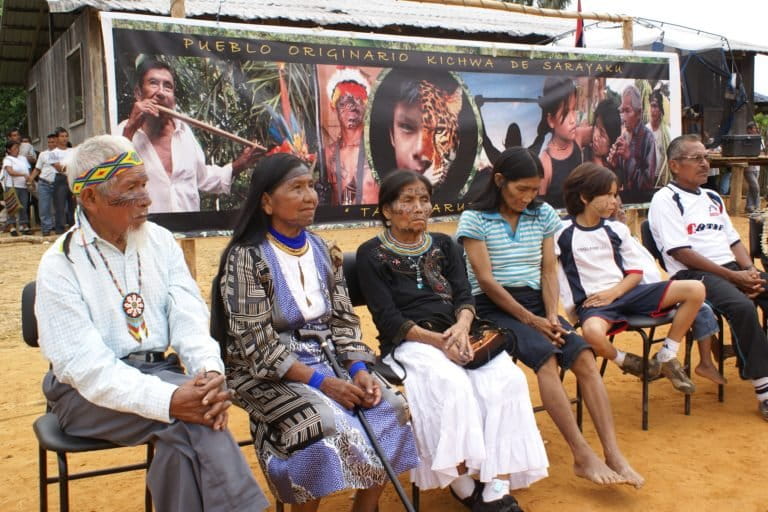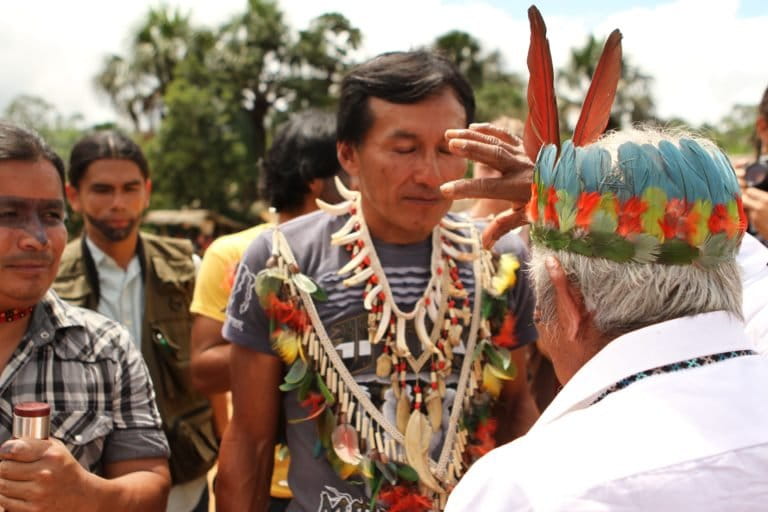
- Sabino Gualinga was a yachak, or shaman, from the Kichwa nation of Sarayaku in Ecuador’s Amazon Rainforest, best known for his testimony before the Inter-American Court of Human Rights, where he explained the idea of the “living forest” and helped win a ruling in favor of his community.
- Gualinga, who spent his entire life in the Amazon, passed away on Feb. 8 at the age of either 97 or 103, depending on whether one consults the state or church registries.
- Gualinga had long taught the Sarayaku community that the forest is alive, which includes the flora, fauna and protective beings that look over all elements of the forest and live among humans.
- The Sarayaku community has since developed this worldview into a political declaration known as Kawsak Sacha, or “living forest” in Kichwa, demanding this sacred connection to their territory be legally recognized.
QUITO — Its a sad moment for any Indigenous community when spiritual leaders, those who hold the knowledge of sacred ceremonies and traditions, pass away from this world. But Sabino Gualinga’s passing has left behind a trail of tears beyond Ecuador’s borders. The prominent yachak, or shaman, from the Kichwa community of Sarayaku in the Amazon Rainforest was well known for leading ayahuasca ceremonies, opening meetings or protests with a tobacco ritual, and teaching the complex lessons of the Kawsak Sacha (“Living Forest”) to Sarayaku and the world.

Family members said Gualinga died peacefully in his bed on Feb. 8 in the Amazonian city of Puyo, surrounded by his seven children. He was either 97 or 103 years old, depending on whether one consults the state or church registries, and lived the entire century of his life in the rainforest.
His daughter, Patricia, described him as a sweet and calm person who didn’t speak much. But when he did speak, she said, “his thoughts and words were very strong.”
“He was a person whose presence alone produced respect, and for that reason many people loved him,” she told Mongabay.
Patricia witnessed this firsthand, as she often served as her father’s translator, from Kichwa to Spanish. In 2011, she translated his famous testimony before the Inter-American Court of Human Rights in Costa Rica, in the trial of Sarayaku vs. Ecuador.
From the witness stand, Sabino Gualinga, then either 87 or 93 years old, and dressed in his colorful feathered headdress, testified against the state, explaining to a room full of lawyers and government representatives how oil exploration near Sarayaku had harmed the spirituality and harmony of the community. Blasts from the seismic testing had also displaced the nearby spiritual beings, he said.

“Half the beings that preserved the ecosystem have now gone … They are the ones that
maintain the jungle, the woods … All those who wish to cause damage don’t understand what they are doing. We do understand it, because we see it,” he said.
The following year, the court ruled in favor of Sarayaku, repeatedly citing Gualinga’s testimony as a basis for their decision.
Carlos Mazabanda, coordinator of the Indigenous program Todos los Ojos en la Amazonia, was also present at the 2011 hearing. He called Gualinga’s testimony powerful, as he referred to Sarayaku territory not only as a piece of land important for the Kichwa way of life, like hunting and fishing, but rather as part of a living forest, with which the Kichwa have a strong spiritual relationship.
“This is the most complicated part, which I think is difficult for the state and for the Western worldview to understand,” Mazabanda said.
Kawsak Sacha, the living forest
Following their legal victory, the community of Sarayaku decided to put this worldview into writing, for the rest of the world, particularly scientists and policymakers, to recognize the cosmovision that the forest is alive. In 2018, the community launched a website explaining this framework, which they call Kawsak Sacha, or “Living Forest” in Kichwa, demanding that their territory be recognized as sacred.

Daniel Santi, a Sarayaku leader and coordinator of the Kawsak Sacha declaration, said Sabino Gualinga was one of several yachak who continuously taught the community that the forest is alive. This means that not only is it made up of living things, like flora and fauna, but also protective beings that look after the trees, lagoons, waterfalls and other elements in the forest, and that live alongside humans.
“Each protective being controls their ecosystem,” Santi said. “That’s what he taught us. If there is an imbalance, like excessive hunting, or excessive logging … the protective being that controls that ecosystem will die or else it will get angry.”
Patricia recalled several moments from her childhood when her father taught her the importance of maintaining this equilibrium with the forest, especially to correct the “reckless habits” she learned in the city, she said. On one occasion, she was using laundry detergent to wash her clothes in a part of the river where this was prohibited, when a sudden thunderstorm broke out and the river began to rise quickly.
“I was scared,” she told Mongabay, “but dad told me that this is what happens when you use odors that the beings in nature here are not used to.”

When it comes to extraction projects, Santi said, major imbalances have been created across the Amazon, which have led to “social, environmental, and cultural problems.” This is why the yachak teachings and the Kawsak Sacha declaration are so important, he said, “to know how to maintain balance in the future, so that there is no stress or big problem, like the one we are facing now with climate change.”
Later this year, the community plans to submit a proposal directly to the Ecuadoran government for Kawsak Sacha to be legally recognized as a new category of protected area, Santi said.
Patricia said the Kawsak Sacha declaration wasn’t launched until 2018 because it was complicated to put into words, but the yachak teachings, including those of her father, have been directly involved in its development since the beginning.
“What [yachak] have been asking for is that a new consciousness can come to shake up global society, with a deep sense of protecting creation, ecosystems and this planet,” Patricia said, adding, “That was [my father’s] fundamental message.”
Sabino Gualinga was survived by his seven children, 23 grandchildren, five great-grandchildren, and three great-great-grandchildren. He was honored with a wake in the city of Puyo, before being taken back to Sarayaku for a special burial ceremony on Feb. 10.

Banner image: Sabino Gualinga in a forest in the Ecuadorian Amazon. Image courtesy of Heriberto Gualinga.
FEEDBACK: Use this form to send a message to the author of this post. If you want to post a public comment, you can do that at the bottom of the page.
Sabino Gualinga, Amazon shaman and defender of the ‘living forest,’ passes away
Source: Trends News

0 Comments